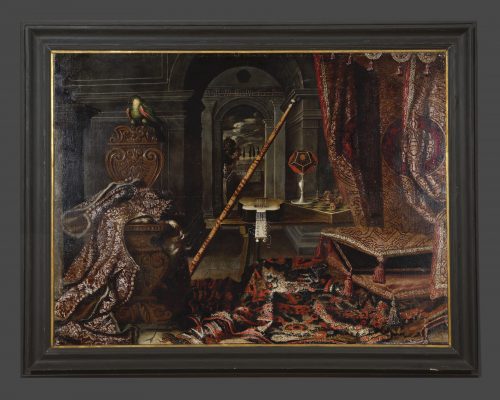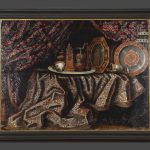11095 AN UNUSUAL PAIR OF BAROQUE STILL LIFE PAINTINGS DEPICTING INTERIORS FURNISHED WITH OBJECTS RELATING TO THE MEDICI FAMILY IN THE MANNER OF CARLO MANIERI Probably Rome. Second Half Of The Seventeenth Century. Framed: Width: 84 1/2″ (215 cm); Height: 66″ (168 cm). Sight Size: Width: 72 1/2″ (185 cm); Height: 53 1/2″ (136 cm).

Research
Oil on canvas. One painting depicting a baroque interior furnished with a variety of objects including tapestries, musical and scientific instruments, a chess board and a parrot. The other depicting a table covered and surrounded by billowing damask, and set with numerous objet d’art including chargers, ewers, a mirror and a clock.
This highly interesting pair of Italian late-Renaissance paintings was executed by an artist working in a specific mode of still life painting in the early 17th century devoted to the presentation of sumptuous objects and realistically rendered textiles in an interior setting. “Rome was the epicenter for producing this typology of still-life,”1 and the ‘artistic patriarch’ of this group of painters, known as Fioravanti (fl. ca. 1650), excelled at rendering rich draperies, vases, fruit, flowers and musical instruments. A compelling possibility for the author of the present painting is Carlo Manieri (fl. 1662-1700), who almost certainly passed through Fioravanti’s workshop.2
Despite the large number of works by or attributed to Manieri, very little is known about the artist. He originally came from Taranto, but settled in Rome where he was admitted to the Congregazione dei Virtuosi at the Pantheon in 1662. His name appears in noble Roman collections, such as the Colonna and Gonzaga family inventories. Compositionally, Manieri’s Richly Decorated Interior with the Banner of the Papal States, dating from the mid-17th century, is comparable to the present painting (figure 1). In the foreground, objects and fabrics are arranged predominantly to the left and right, while a flag lays diagonally at the center. There is also a guitar whose neck extends out almost directly toward the viewer, similar to the present painting. Although the main focus is on the diverse objects of the foreground, Manieri combines this with a deep perspective that incorporates architectural elements of the room they are in.
The painting comprising a view of a furnished interior with distant courtyard apparently depicts items from the collection of the Medici. The curtain on the right side of the painting very much resembles the pomegranate pattern on the fabric of Eleanor de’ Medici’s (1522-1562) dress made famous by her portrait by Agnolo Bronzino in the Uffizzi gallery (figure 2). On the left side, the fur-lined coat with slitted sleeves appears to be of the type made fashionable by the the family, worn by Cosimo I de’ Medici and his illegitimate son Giovanni de’ Medici, among others (figure 3).
Amongst the various objects throughout the picture is a polyhedral sundial, which bears the Medici arms. It is very related to one still in the Museo Galileo, which was commissioned from Stefano Buonsignori by Francesco I de’ Medici circa 1587 (figure 4). Even bigger patrons and enthusiasts of the sciences were Cosimo II de Medici and his sons, Ferdinando II de’ Medici and Leopoldo de’ Medici (later a cardinal). They were students of Galileo, obsessed with science and technology, and established the Accademia Platonica, and the Accademia del Cimento. The sundial rests upon a chessboard, which may allude to the Medici’s diplomatic strategies in the proverbial chess game of Italian politics.
It has been suggested that the long pole in the center of this painting is a telescope, supported once again by the Medici’s deep interest in the sciences, as well as surviving examples in the Museo Galileo. Roman instrument maker Giuseppe Campani sent multiple telescopes measuring 10 palms (corresponding to 2230 mm,3 or just over 7 1/4 feet) to Ferdinando II de’ Medici in the mid-1660s. One of these, sent in 1664, is covered with marbled paper (figure 5), resulting in a similar effect to the mottled appearance of the staff in the present painting, which could possibly represent one of Campani’s models. The staff may also be fashioned from a type of exotic wood.
While clearly belonging to the aforementioned school of still life painting, the present tableau is set farther back from the picture plane and the typical abundance of richly ornamented textiles is pared down, alleviating some of the characteristic horror vacui found in pictures of this type. Instead, the objects, of a definite importance and symbolism, stand out for consideration by the viewer.
The pendant picture also conforms to the genre, and depicts a table covered and surrounded by billowing damask, and set with numerous objet d’art including chargers, ewers, a mirror and a clock. It has been suggested that these items of silver may be from the Medici collections as well. Unfortunately, however, a great amount of the Medici’s silver and gold was looted and melted down by Napoleon’s troops circa 1799 to finance his wars.
Leopoldo de’ Medici (1617-1675) stands out as a possible candidate for having commissioned these paintings. As mentioned above, he was extremely passionate about science, and a posthumous inventory of his possessions made in 1675-76 contains numerous entries for scientific instruments and exotic materials, as well as chess boards and expensive fabrics. Furthermore, as a cardinal, he frequently traveled to Rome at the time this circle of artists was working there. The 1713 inventory of Ferdinando de’ Medici included a still life with cushions, vessels and fruits, described as by Fioravanti,4 confirming that this type of painting was within the scope of the Medici tastes.
The difficulty in distinguishing paintings by artists in this group from one another, and the paucity of archival documents naming them, has only recently begun to be addressed by scholars. Despite this, it would appear that Manieri’s oeuvre remains the most closely comparable to the present paintings.
Footnotes:
- Bocchi, Gianluca, and Ulisse Bocchi. Pittori Di Natura Morta a Roma: Artisti Stranieri 1630-1750. Viadana [Italy: Editrice Arti grafiche Castello, 2004. 394.
- Walker, Stefanie, and Frederick Hammond. Life and the Arts in the Baroque Palaces of Rome: Ambiente Barocco. New York: Published for the Bard Graduate Center for Studies in the Decorative Arts, by Yale University Press, 1999. 77.
- “Terrestrial Telescope.” Medicean Skies. Museo Galileo, n.d. Web. <http://www.imss.fi.it/news/cielimedicei/03/estrumento3.html>.
- Walker, 76.






Comments are closed.